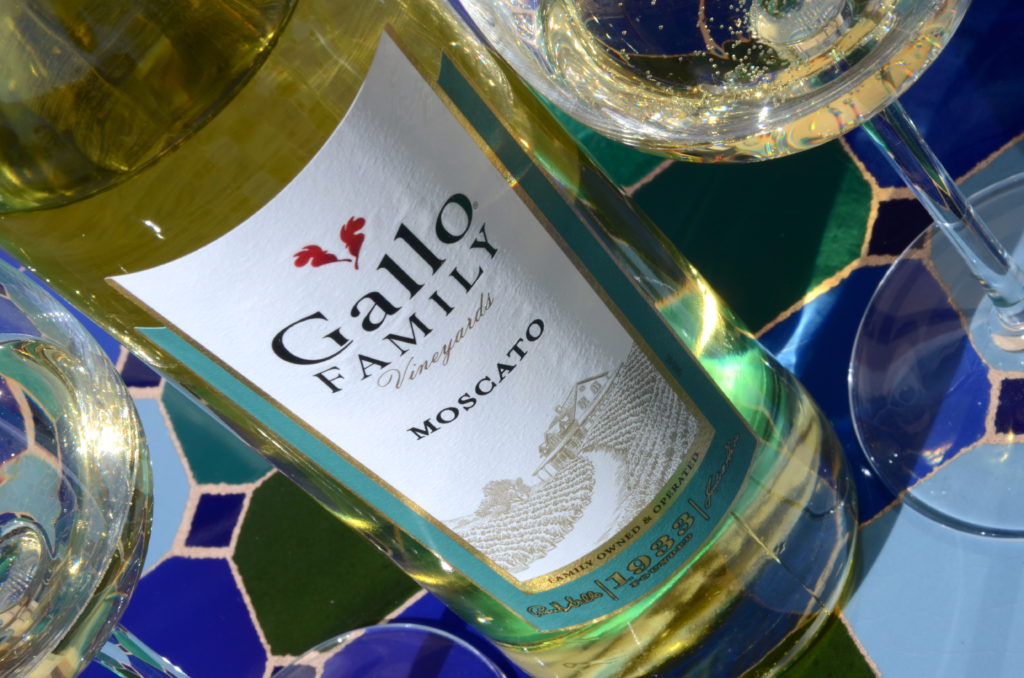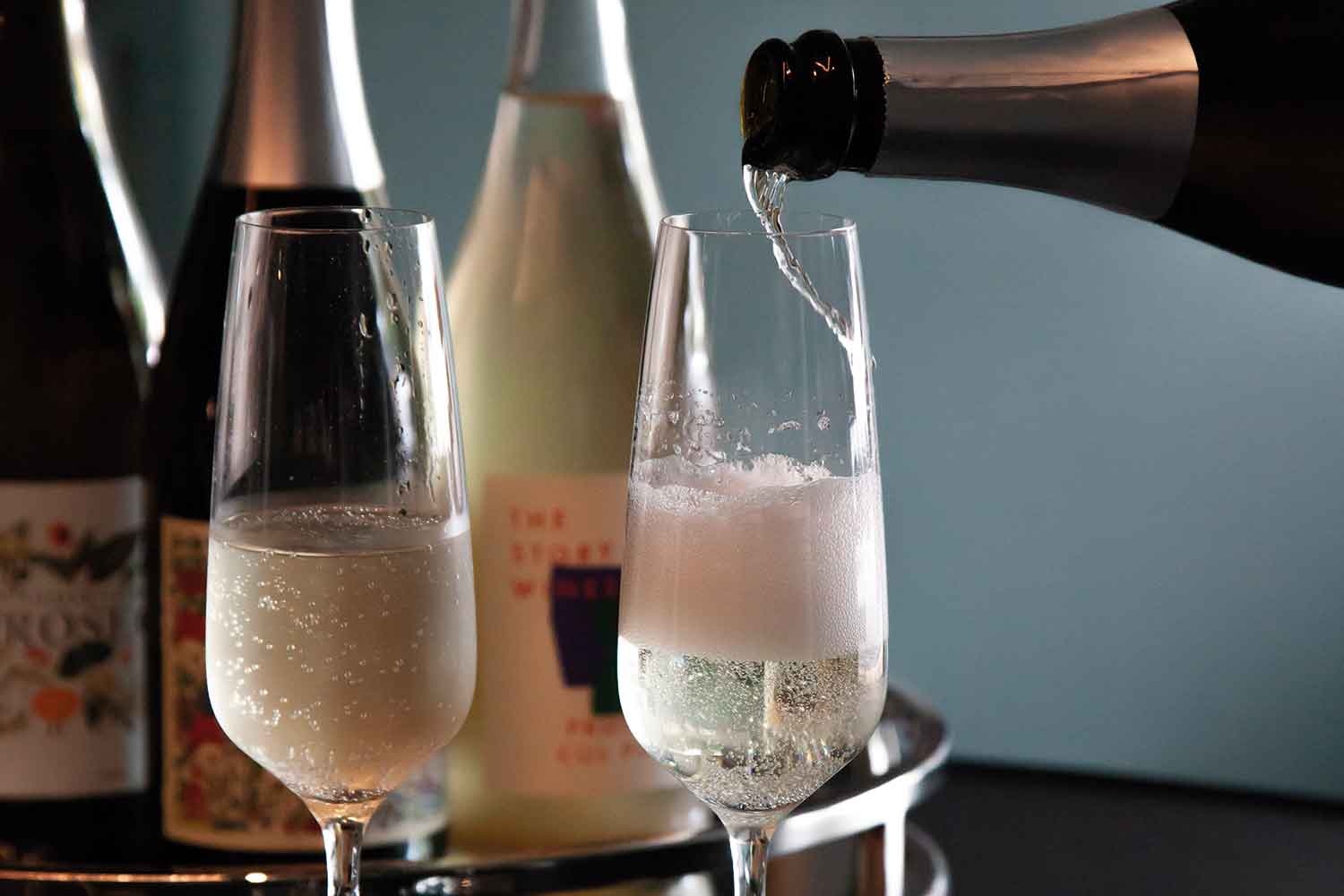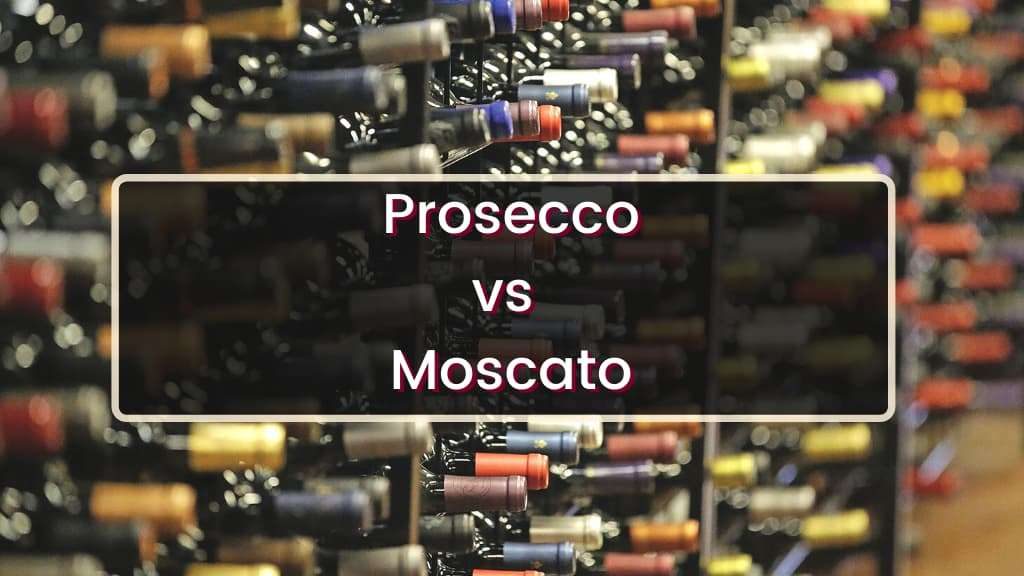Most drinkers are comfortable with the dryness of Prosecco wine which offers a fruity crispness and tingling acidity on the palate. Despite having comparable flavor characteristics including honeydew, melon, apple, and pear, Moscato is a sweeter bubbly wine that has less acidity.
Because the two wines are popular sparkling wines from Italy, they are often mixed up. They also have some similarities, but most of the wine features are different. So, what’s the difference between Moscato and Prosecco? Follow our guide below to thoroughly understand your favorite wine and find out the answer.
Things To Know About Moscato
Moscato is a popular Italian wine made from Muscat grapes, which offers a sweet and fruity taste with low acidity. The Muscat grape is known as one of the oldest grape varieties which is grown around the world.

Typically served as a dessert wine, Moscato is sweet with flavors of juicy pear, honeysuckle, melon, and orange blossoms. If you’re used to drinking dry, acidic white wines like Chardonnay or Sauvignon Blanc, Moscato is the complete opposite: it’s so sweet, fresh, and filled with fruit on your palate. Low acidity and high sugar content in Muscat grapes both contribute to the wine’s notable sweetness.
Consumption of Moscato has increased recently as more people seek out sweet, light-bodied wines with lower alcohol content. This wine is ideal for beginners because of its affordable pricing, and lovely fruity and flowery tastes, but it can also be complicated enough for a wine expert to enjoy.
Things To Know About Prosecco
Made from the Glera grape, Prosecco is a sparkling wine produced exclusively in northern Italy’s Veneto area. This is a delightful bubbly wine known for its fresh and light taste of fruit.

The majority of Prosecco wines are made in a dry style. It frequently tastes sweeter with notes of pear, honeydew melon, and green apple. Although the brut is considered the most favorite Prosecco’s sweetness level available on the market at present, you can still discover sweeter types.
Prosecco is extremely flexible and goes well with a variety of food types. It’s among a few wines that pair well with the main dish and also with an appetizer.
Moscato vs Prosecco: What Is The Similarity?
Moscato and Prosecco are both Italian bubbly white wines. Due to their similar looks and shared Italian origin, they were often mixed up.
You likely wouldn’t be able to tell the difference between the two wines if you just looked at their appearance when placing them next to each other. Even though Prosecco may appear to be a sweet-tasting wine, it is often extremely dry, whereas Moscato is sweet. They will work with different food items because of the difference in sweetness levels.
What Is The Difference Between Moscato And Prosecco?

1. Origin
Moscato wine has its roots in Italy, but it has been made all over the world due to its grape’s adaptability to a variety of climates. It is a centuries-old wine with Greek and Egyptian ancestors, according to historical records.
Prosecco is produced in the little area called “Conegliano” in the Veneto region of northeastern Italy. It was first introduced there and gained popularity gradually in Italy. Nowadays, this wine has become well-known across the globe.
2. Grape Variety
Muscat grapes, which have green to yellow skins and are grown in Italy, Spain, Greece, and France, are used to make Moscato.
Muscat is regarded as the truest grape expression in Italy and France, keeping its flowery notes. Muscat Blanc is the most popular type of this grape used for producing Moscato.
Glera is a thin-skinned grape varietal that has been produced in Vento for several centuries and is used to make Prosecco.
Glera makes up 85% of the volume of Prosecco in Italy, with additional fruits and tastes forming up the remaining 15%. Prosecco wine won’t be valued if the Glera content is less than 85%, however, worldwide winemakers disregard this rule and utilize the label for their own targeted tastes.
3. Tasting notes
Most people associate Moscato wine with sweetness and a light sparkling feature. Moscato has a light body and fruity flavors ranging from honeysuckle, pears, lemons, and orange blossoms. The mouthfeel of Moscato wine is sweeter, although this entirely depends on the producer and the type of taste he is attempting to produce.
This wine also offers nectarine notes that make you feel relaxed and refreshed like walking in the summer forest. It is undoubtedly a dessert wine that is perfect for any situation.
In general, Prosecco is a dry bubbly white wine with flavors of green apples, pears, melons, citrus, and honeydew. It is a crisp, fresh, flavorful wine with a lot of acidity.
The mouthfeel is a bit sweet, refreshing, and pleasant, and finishes impressively at the throat. Despite being dry, Prosecco has a great balance because of its sweet fruity, and honey tastes.
The sweetness and delicate notes of Meyer lemons, peaches, and oranges in DOCG Moscato d’Asti distinguish it from Prosecco wine. Prosecco is drier and crisper, while Moscato is deeper in taste profile.
4. Aroma
The aroma of Moscato is more unique and more intense, and Moscato d’Asti boasts one of the most wonderful aromas among all Italian wines. It smells mainly of fruit, including Meyer lemons, peaches, orange blossoms, tropical fruits, and cinnamon (in wines from the north).
Prosecco‘s aroma is lighter and similar to a tropical smell with green apple and pear as the main theme, in addition to hazelnut, melon, etc. The wine is produced using the “tank method” that helps to keep the fresh, fruity aroma
5. Alcohol content
Prosecco wine displays medium to high acidity levels, is rather dry, and typically contains approximately 12% alcohol.
Moscato, on the other hand, is lighter and sweeter with a lower alcohol content of 5% to 7%.
6. Sweetness
The key difference between Moscato and Prosecco is sweetness. Moscato is sweet whereas Prosecco is dry style.
Prosecco has half as much sugar content as Moscato which is made naturally from the sweet Muscat grape.
In contrast to Moscato, Prosecco has been produced in dry to ultra-dry styles, or brut styles. “Brut” is a French word meaning dry.
7. Food pairings
Given that Moscato is a sweet wine, it will pair well with Mexican cuisine, spicy Asian dishes, pasta, risotto, chicken, oyster, and beef nachos.
Additionally, Moscato can go with desserts. Several popular suggestions are fruit tarts, Pandoro, dried fruit, and sponge cakes.
Prosecco is a very flexible wine that goes well with many different foods. Cured meats, fresh cheeses, oysters, fish, fries, risotto, and pasta are some typical Prosecco food pairings.
It also works well with creamy foods, grilled meats, and barbecued chicken.
8. Price
Both wines are available at a reasonable price.
For Prosecco, budget between $10 and $20 for an okay bottle, and over $35 if you want the more expensive type such as Rive, Prosecco Superiore, and Cartizze.
The price range for Moscato wine is from $10 to $20.
A summary of the differences between Moscato and Prosecco:
| Factor | Moscato |
Prosecco |
| Origin | Originated in the northwest region of Italy and then spread to France, Spain, and Australia. | Produced in the little area called “Conegliano” in the Veneto region of northeastern Italy. |
| Grapes | Muscat (Muscat Blanc) grape | Glera grape |
| Tasting notes | Low acidity; very sweet with notes of peach, honeysuckle, pear, lemon, and orange blossoms | Higher acidity; crisp, fruity tastes with notes of green apples, pears, melons, citrus, and honeydew |
| Aroma | Intense aroma with lemons, peaches, orange blossoms, tropical fruits, and cinnamon | e aroma is lighter and similar to the tropical smell with green apple and pear as the main theme, in addition to hazelnut, melon, etc. |
| Alcohol content | 5-7% | 12% |
| Sweetness | Sweet | Dry or but food |
| d pairings | It pairs well with Mexican cuisine, spicy Asian dishes, pasta, risotto, chicken, oyster, and beef nachos. It also can go with desserts | t can work well with cured meats, fresh cheeses, oysters, fish, fries, risotto, pasta, and barbecued chickens |
| Price | $10 – $20 | $10 – $40 |
You might also like:
- Do You Put Red Wine in A Wine Cooler?
- Is Igloo a Good Cooler? – Find Out What the Experts Say
- Common Problems With Wine Coolers | Reasons and Solutions
Moscato vs Prosecco: Which Wine Is Best For You?
Whether you choose Moscato or Prosecco depends on your wine preferences. If you love sweet wines that have fruity, flavorful tastes, Moscato is the wise choice for you.
Prosecco, on the other hand, is known to be dry, a bit sour, and fruity for people who prefer crisp and light white wines.
Moscato vs Prosecco: Ideal serving temperature
Lower serving temps from 42 to 46°F (5.5-8°C) are ideal for Moscato and Prosecco. Both wines are excellent at these low temperatures without losing their floral and delicate characteristics.
Although any wine can be served in a conventional wine glass, flutes glasses or Champagne glasses will be better options since they feature a rim that prevents the bubbles from overflowing. A thin glass also aids in preserving the taste while maintaining the wind chill.
FAQs
1. Can I substitute Prosecco for Moscato?
Yes, you can. Prosecco is a sparkling white wine with Italian origins. It has sweet tastes similar to Moscato d’Asti, featuring apple and melon topping the tongue. However, Prosecco is drier, a bit sour, and has a higher alcohol content than Moscato. Brut Prosecco is the drink of choice for people who are willing to venture just a little beyond their sweet zone.
2. Which one is sweeter, Moscato or Prosecco?
The answer is Moscato. This wine is ideal if you expressly prefer a sweet wine because it tends to be on the sweet side.
3. Which is more popular, Moscato or Prosecco?
There are several reasons why Prosecco is more well-known than Moscato. Moscato is rarely sold and is not popular, while Prosecco is highly promoted in the United States and Europe for being a lighter, less expensive substitute for Champagne.
Because it is produced in greater quantities than Moscato, you may get Prosecco at more establishments, particularly supermarkets and liquor stores.
Wine connoisseurs who are familiar with Moscato’s characteristics and features tend to favor it.
4. Is Prosecco a sweeter wine?
The most popular Prosecco wine styles are dry or extremely dry. However, because of the grape’s fruity notes, they frequently taste sweeter than they truly are.
5. Which wine is more expensive, Prosecco or Moscato?
Both Moscato and Prosecco are affordable wines. In comparison, Moscato is usually a bit more expensive.
6. When should I drink Moscato?
Moscato has a sweet taste, thus it goes best with meals that have opposite taste profiles such as bitter, salty, spicy, or sour. Moscato is excellent with dessert, appetizers, and by itself as an aperitif, even though its sweet fruity aroma might make it challenging to serve with the main dish.
Conclusion
We have analyzed the difference between Moscato and Prosecco based on 8 factors: origin, grape variety, tastes, aroma, alcohol content, sweetness, food pairings, and price. Both wines come from Italy, but Prosecco is a bit more famous. They also taste quite different: Moscato is sweet while Prosecco is dry and fruity. Read our reviews above carefully to choose the ideal wine for you.

With over a decade of experience in viticulture, Simon Conner is the perfect writer to help you find and maintain your prized vintages. As an expert on food, wine, and kitchen products, he offers his expertise to guide clients through every step involved with collecting and selling wines.

